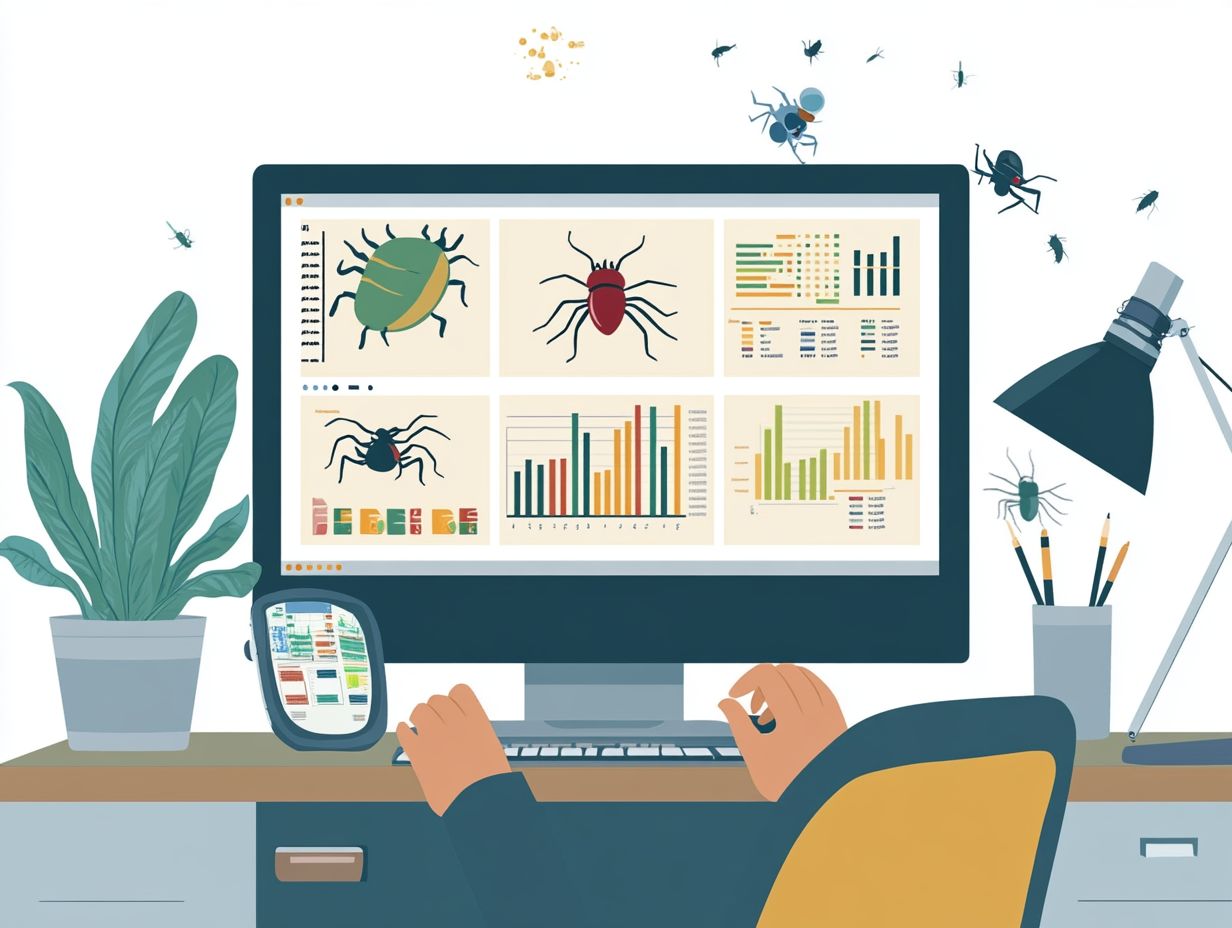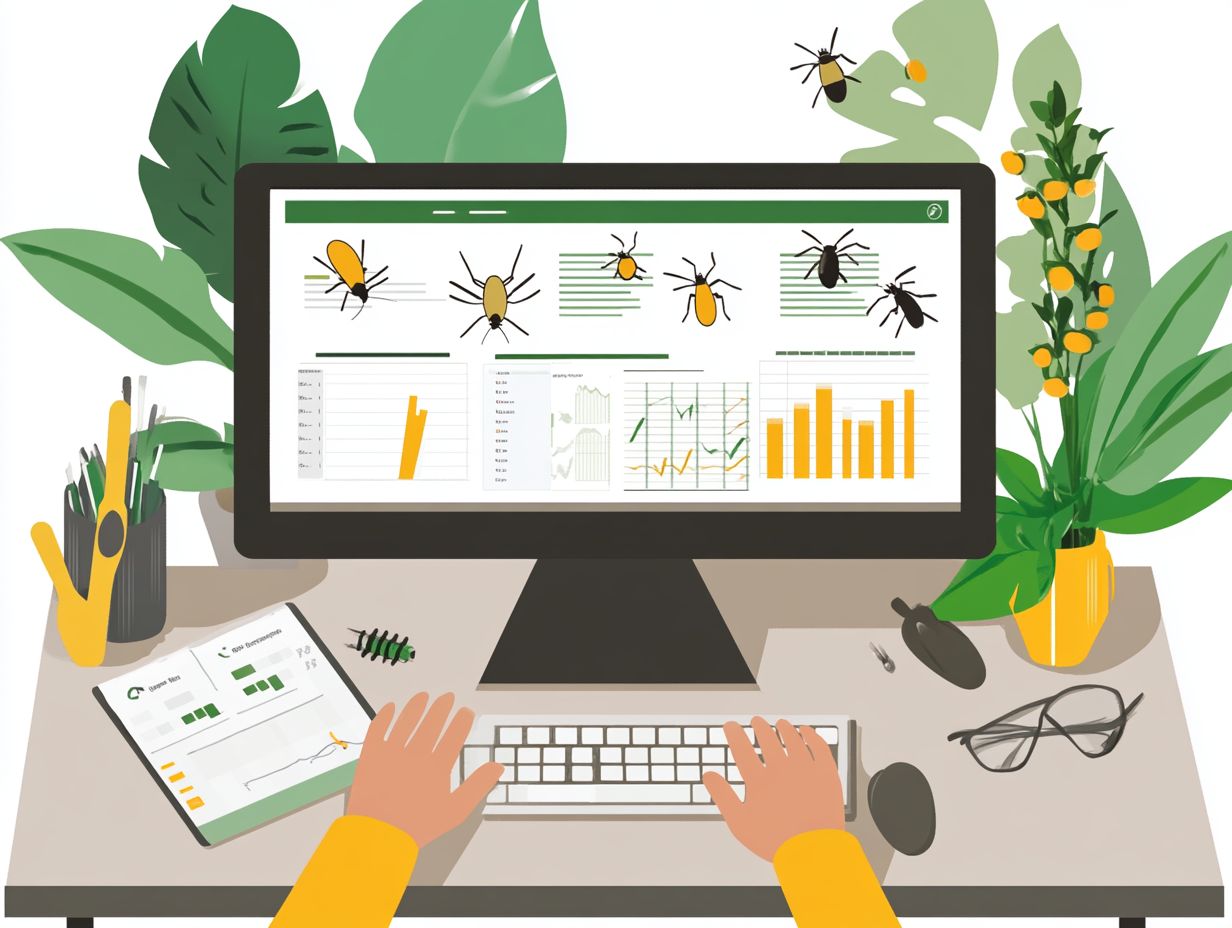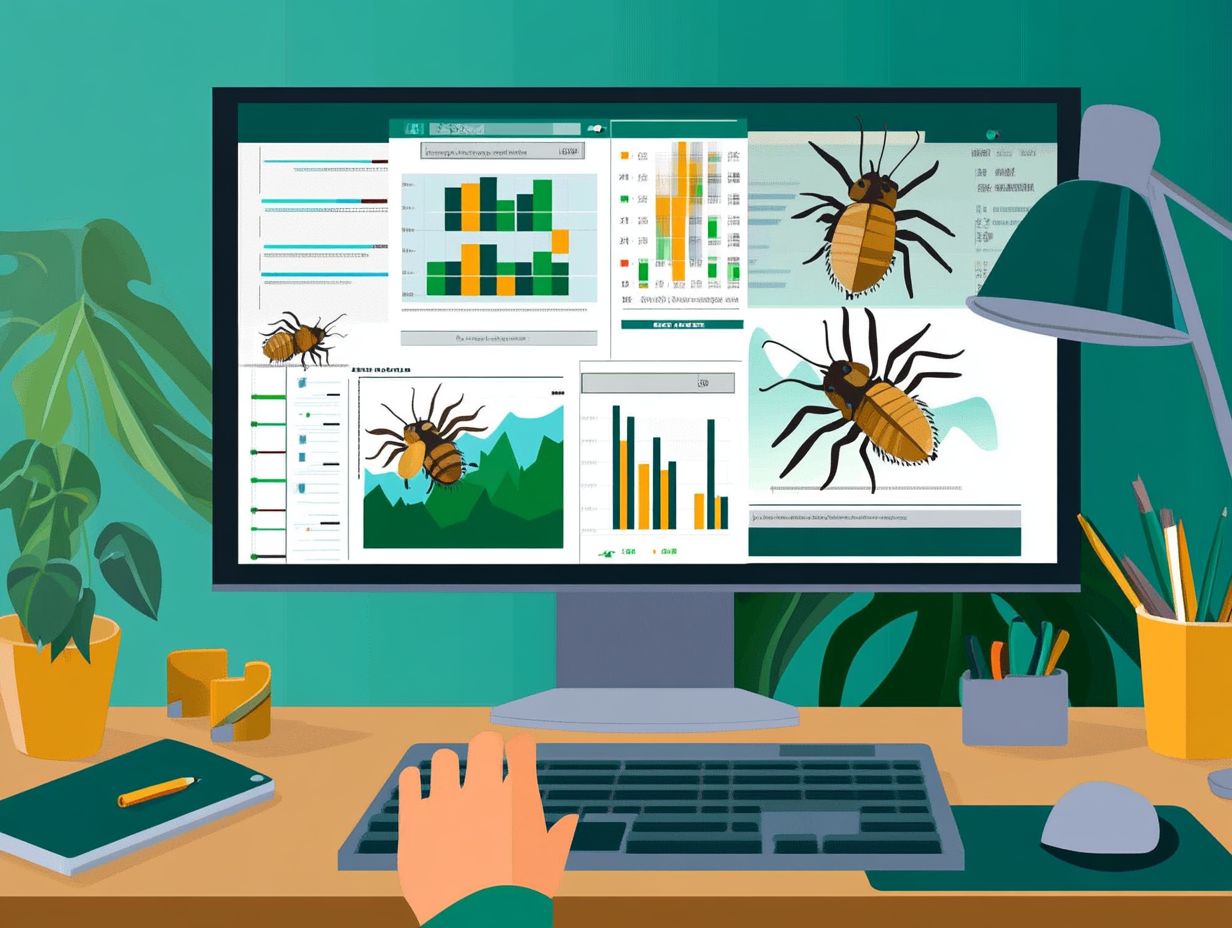In today’s digital age, you can’t just rely on traditional marketing strategies to attract clients for your pest control business. The online landscape is bursting with opportunities for you to connect with potential customers, boost your visibility, and drive your business growth.
This article dives into why digital marketing is crucial for pest control companies, showcasing its many benefits and diverse strategies like SEO, PPC, and social media marketing. You’ll also find tips on how to craft an effective digital marketing plan and check out successful campaigns that could spark some ideas for your own efforts.
So, let’s explore how you can tap into digital marketing to stay ahead in this competitive industry!
Why is Digital Marketing Important for Pest Control Businesses?

Digital marketing is crucial for pest control businesses because it provides a strong platform for you to connect with your target audience, build brand recognition, and boost customer engagement through effective online advertising strategies.
In such a competitive industry, using digital marketing techniques like SEO, online ads, and reputation management can really make a difference in your business growth and customer acquisition efforts.
By embracing these strategies, you'll not only optimize your local SEO but also enhance your overall digital visibility, making it easier for you to reach potential customers effectively.
What Are the Benefits of Digital Marketing for Pest Control?
Digital marketing offers plenty of perks for pest control businesses, like boosting your online visibility, generating effective leads, and optimizing conversion rates, which can lead to higher sales and happier customers. By using strategies like content marketing, social media engagement, and email marketing, you can build a strong online presence while encouraging customer reviews and social proof that enhance your reputation.
These methods not only deepen customer engagement but also help you snag valuable leads, making it easier to connect with potential clients. For example, when you create engaging content that educates homeowners about various pest problems, you position your business as an authority in the industry, prompting consumers to turn to you for expertise.
Positive online reviews act like powerful testimonials that sway decision-making, motivating new customers to take action. As you work on enhancing your online reputation, you’ll attract more inquiries and foster loyalty, which ultimately drives sustained business growth.
What Are the Different Types of Digital Marketing Strategies for Pest Control?
You have a bunch of digital marketing strategies at your fingertips that can help your pest control business effectively reach your target audience, boost customer engagement, and drive those sales up.
Think about using Search Engine Optimization (SEO) to improve your organic search rankings, or Pay-Per-Click (PPC) advertising for that instant visibility you crave. Social media marketing is a great way to engage with your customers, while email marketing allows you to communicate directly with them.
Don’t forget content marketing, which helps you provide valuable information to potential clients and establishes your authority in the pest control industry.
1. Search Engine Optimization (SEO)
Search Engine Optimization (SEO) is an essential digital marketing strategy for pest control businesses like yours. It helps improve your website's visibility in organic search results through effective keyword research and local SEO techniques. By optimizing your website content and structure, you can attract more traffic from potential clients who are actively searching for pest control services in their area.
Understanding the fundamental components of SEO is key for your business. Effective keyword research allows you to identify the specific terms and questions that potential customers are using to find solutions, ensuring that your content aligns with what they’re actually looking for.
On-page optimization is all about enhancing your web pages with relevant titles, meta descriptions, and headers. This can improve your site's performance in search rankings. Plus, implementing local SEO tactics can significantly boost your visibility in localized searches, helping guide potential customers right to your services nearby.
By leveraging these strategies, you can enhance your online presence and ultimately drive more organic traffic to your pest control business.
2. Pay-Per-Click (PPC) Advertising
Pay-Per-Click (PPC) advertising, especially through platforms like Google Ads, is your ticket to placing targeted ads that can generate immediate traffic and leads for your pest control business. Think of it as a must-have in your online advertising toolkit. By carefully crafting your PPC campaigns and optimizing them for conversion rates, you can make sure that every dollar of your advertising budget is working hard to give you the best return on investment.
This approach not only grabs attention but also lets you focus your resources on specific demographics, ensuring your message gets in front of potential customers who are actively searching for pest control solutions. With such precise targeting, you can create personalized ad experiences that really resonate with your audience, driving higher engagement and click-through rates.
Focusing on conversion rate optimization is key; it turns those initial clicks into meaningful transactions or inquiries. In the end, using PPC effectively can seriously boost your lead generation efforts, leading to sustainable growth and increased brand visibility in this competitive market.
3. Social Media Marketing
Social media marketing is a powerhouse for pest control businesses, giving you a fantastic platform to engage with your customers, share valuable content, and connect with your community. By using eye-catching visuals and tapping into different social media channels, you can boost customer engagement and build lasting relationships with your audience.
You have the opportunity to create compelling visual stories that not only inform but also resonate with your target audience, turning casual viewers into loyal customers. Think about sharing behind-the-scenes glimpses of your operations, customer testimonials, and helpful pest control tips—these strategies can really amp up interaction.
Don’t forget about community outreach! Showcasing your initiatives on social platforms can highlight your commitment to local issues, helping you build trust with your audience. Plus, engaging with customers through interactive content like polls, quizzes, and live Q&A sessions can deepen those relationships even more. It creates a two-way communication channel that fosters loyalty and encourages valuable feedback.
4. Email Marketing
Email marketing is a powerful tool for your pest control business. It allows you to nurture leads and keep in touch with your existing customers through targeted drip campaigns and regular updates. By analyzing customer feedback and tracking conversions, you can tailor your email content to match the needs and preferences of your audience.
This approach not only boosts engagement but also builds trust and loyalty among your clients, making them more likely to choose your services over the competition. By using best practices in email marketing, like segmenting your audience for personalized messaging, you can significantly enhance the effectiveness of your campaigns.
Regularly timed messages can serve as reminders about the importance of pest control and seasonal services, ensuring that you’re the first one they think of when they need help. By closely monitoring conversion rates and adjusting your strategies based on data insights, you can optimize your communications to drive customer retention and lead conversion.
5. Content Marketing

Content marketing is a game-changer for your pest control business. It gives you the chance to create informative and engaging content that tackles your customers' concerns and questions, all while boosting your SEO through clever keyword research. This strategy not only ramps up customer engagement but also helps you establish yourself as an authority in the pest control industry.
By using different forms of content like blog posts, infographics, and videos, you can really grab the attention of your target audience. Dive into common pest problems and offer prevention tips in your blog posts to provide valuable insights. Infographics are great for breaking down complex data into easy-to-understand visuals, making information a breeze to digest. And don’t underestimate the power of engaging videos—they can showcase techniques or provide customer testimonials that enhance your brand's story.
When you prioritize quality content creation, you’re not just driving traffic; you’re also building trust and loyalty. Those are the essential ingredients for nurturing long-term customer relationships.
6. Online Reviews and Reputation Management
Online reviews and reputation management are crucial for the success of your pest control business, as they have a big impact on customer trust and decision-making. By actively managing your online presence and encouraging customers to leave reviews, you can boost your digital footprint and provide the social proof that attracts new clients.
When you engage with feedback—both the good and the bad—you’re not just showing your commitment to customer satisfaction. You’re also demonstrating to potential clients that you value their input and are always looking to improve.
Using strategies like asking satisfied customers to leave reviews after your service, thoughtfully responding to concerns, and showcasing testimonials on your website and social media can work wonders. Creating a feedback loop allows you to refine your services, which is key to growth. Not only does this enhance your online visibility, but it also builds lasting trust, making your target audience feel more confident in choosing you for their pest control needs.
How to Create an Effective Digital Marketing Plan for Pest Control?
Creating an effective digital marketing plan for your pest control business involves a few key steps.
- First, you need to identify your target audience—who are you really trying to reach?
- Next, set clear goals for what you want to achieve.
- Once you have that down, it’s time to choose the right marketing strategies to hit those objectives.
- And don’t forget about performance metrics!
By measuring your success, you can keep refining your plan, making sure your digital marketing efforts are effective and actually helping your business grow.
1. Identify Your Target Audience
Identifying your target audience is key for your pest control business. It helps you tailor your marketing efforts to specific demographics and really understand your customers' journey. By using audience segmentation techniques, you can create targeted campaigns that resonate with potential clients and effectively address their needs.
Understanding the different characteristics of various customer groups not only makes your promotional strategies more relevant but also helps you build a deeper connection with your clients. This insight allows you to adapt your messaging so it speaks directly to the pain points and expectations of your potential customers.
Recognizing the various stages of the customer journey—from awareness to decision-making—enables you to engage clients effectively at each step. This strategic approach can lead to higher conversion rates and increased customer loyalty, setting you up for sustainable growth and success in a competitive market.
2. Set Goals and Objectives
Setting clear goals and objectives is crucial for your pest control business when it comes to creating a digital marketing plan that actually drives results and helps you grow. By establishing specific performance metrics and conversion tracking methods, you can evaluate how well your marketing strategies are working and tweak them as needed to hit those targets.
Using the SMART framework can really amp up your goal-setting game. Each goal should be:
- Specific: Clearly define what you want to achieve.
- Measurable: Make sure you can track your progress with key performance indicators.
- Achievable: Set goals that are realistic based on the resources you have.
- Relevant: Align your goals with the bigger picture of your business objectives.
- Time-bound: Give yourself a clear deadline for when you want to get things done.
These practices not only bring clarity but also motivate you and your team to aim for well-defined successes in your digital marketing efforts. By consistently monitoring these performance metrics, you can make timely adjustments to keep your digital strategies in sync with the ever-changing landscape of pest control services.
3. Choose the Right Digital Marketing Strategies
Choosing the right digital marketing strategies is crucial for your pest control business if you want to effectively reach your target audience and hit your goals. Whether you’re diving into search engine marketing for visibility, content marketing for engagement, or PPC for those quick wins, aligning your strategies with your objectives will lead you to greater success.
To figure out the best approaches, you first need to clearly define your business goals. Are you looking to boost brand awareness, generate leads, or improve customer retention? Understanding the specific needs and preferences of your target audience is also super important. For example, using social media can enhance community interaction, while email marketing can help you nurture those client relationships over time.
Don’t forget to analyze what your competitors are doing well and how they engage their audience. This can give you valuable insights into effective strategies. Ultimately, taking a systematic look at potential digital channels will help you make informed decisions, ensuring that you allocate your resources effectively for maximum impact.
4. Create Engaging and Relevant Content
Creating engaging and relevant content is key for pest control businesses like yours to grab your audience's attention and boost customer engagement. By adding strong calls-to-action and using visual elements, you can really enhance the user experience and encourage potential clients to dig deeper into your services.
In today’s competitive landscape, the quality of your content is everything when it comes to attracting and keeping customers. Well-crafted articles, informative videos, and eye-catching infographics not only educate but also entertain, helping to keep visitors on your page longer.
When you seamlessly integrate relevant keywords into your content, you’ll boost your search engine visibility, making it easier for customers to find you online. Sharing actionable insights, like pest prevention tips, along with visually appealing graphics can really foster engagement.
By regularly updating your content and addressing customer pain points, you can establish your business as an authoritative voice in the pest control industry. This will help ensure ongoing interactions and build customer loyalty.
5. Utilize Local SEO Techniques

Utilizing local SEO techniques is crucial for your pest control business because they help you connect with customers right in your service area while also optimizing your website for local search results. By setting up Google My Business, managing your online citations, and optimizing your website, you can boost your visibility in the local market.
These strategies are the backbone of an effective marketing plan, allowing your business to pop up when potential clients search for pest control services nearby. A well-optimized Google My Business listing can really ramp up customer engagement by providing them with important information like your location, hours, and the services you offer.
Keeping your local citations accurate across various directories not only boosts your credibility but also makes it easy for people to find your business. When you combine these tactics, you not only improve your search rankings but also establish a trustworthy online presence, attracting more targeted leads that are essential for growing your pest control enterprise.
6. Monitor and Analyze Your Results
Monitoring and analyzing your results is key for pest control businesses like yours to really get a grip on how effective your digital marketing efforts are and to make smart, data-driven decisions. By using analytics tools to check out your performance and engagement metrics, you can tweak your strategies and get better at tracking conversions.
Regularly analyzing your performance isn’t just about crunching numbers; it’s about gaining valuable insights into customer behaviors and preferences. This knowledge lets you adjust your marketing tactics based on real-time data, helping you figure out which channels are delivering the most engagement and conversions.
By keeping a close eye on things, you can spot trends and identify areas that need improvement, ensuring your marketing efforts resonate with your customers. Ongoing analysis helps you stay flexible in a constantly changing market, allowing you to adapt your overall strategy in ways that can boost customer satisfaction and ramp up your revenue.
What Are Some Successful Examples of Digital Marketing for Pest Control?
You can find plenty of successful examples of digital marketing in the pest control industry that showcase innovative campaigns and effective branding strategies to spark your own marketing ideas.
By diving into case studies of top pest control companies, you’ll gain valuable insights into what actually works in the industry and how to engage your target audience effectively.
1. Terminix's 'Pest of the Month' Campaign
Terminix's 'Pest of the Month' campaign is a fantastic example of a creative digital marketing strategy that really grabs your attention while educating you about common pest issues. This campaign not only shows off Terminix's expertise but also helps establish them as a go-to authority in the pest control world.
By using visually engaging content across various platforms, Terminix managed to capture the interest of a wide audience and spark conversations about pest control. Each month, you could look forward to informative articles, eye-catching graphics, and interactive social media posts that focused on specific pests. This approach created a sense of anticipation and a feeling of community among their audience.
The execution was spot-on, using targeted messaging to reach both existing and potential customers, which really boosted brand recognition. As a result, the campaign led to a significant increase in customer engagement and strengthened Terminix's reputation in the competitive landscape of digital marketing.
2. Orkin's 'Bug Wisdom' Video Series
Orkin's "Bug Wisdom" video series shows you just how powerful video marketing can be for engaging customers. It offers valuable educational content about pest control that not only informs but also helps build brand loyalty and trust with potential clients.
With captivating visuals and expert insights, the series enhances your understanding of various pest-related issues, making it clear that Orkin is a reliable resource you can turn to. This smart approach to video content enriches your interaction as a customer and cements Orkin's reputation as a leader in pest control services.
By focusing on educational yet entertaining material, the brand really demonstrates its commitment to addressing your needs effectively, setting itself apart in the digital marketing landscape. As a result, you’re more likely to engage with the brand and seek out its expertise, highlighting just how important video marketing is in today’s digital campaigns.
3. Rentokil's Interactive Pest Guide
Rentokil's interactive pest guide is a great example of how digital tools can really boost your understanding and engagement with pest issues. It makes it so much easier for you to identify and grasp what’s going on with any pest problems you might be facing. This innovative approach isn’t just a handy resource; it also shows how committed Rentokil is to providing top-notch customer service.
By offering real-time information and easy navigation, the guide enables you to take proactive steps in managing pests. You can dive in and explore different pest types, their habitats, and effective control methods—all while enjoying visuals that make learning feel more engaging.
This kind of digital innovation doesn’t just educate you; it also helps Rentokil stand out as a thought leader in the pest control industry. In the end, this strategy builds trust and loyalty because you’ll feel more informed and confident when choosing Rentokil for your pest management needs.
How Can Pest Control Businesses Stay Ahead in the Digital Marketing Landscape?
Pest control businesses can really stay ahead in the digital marketing game by constantly adapting to industry trends, using analytics, and fine-tuning their strategies for the best results. By embracing new technologies and getting a handle on customer preferences, you’ll set your business up to thrive and keep a competitive edge in this fast-changing market.
1. Keep Up with Industry Trends

Keeping up with industry trends is crucial for your pest control business to stay competitive in the ever-changing digital marketing landscape. When you conduct market research and competitive analysis, you’ll gain insights into which strategies work best and how to adapt to shifting consumer preferences.
Staying informed about market dynamics helps you spot emerging opportunities and potential threats that could affect your operations. Understanding the competitive landscape allows you to recognize not just who the key players are but also what unique value propositions they bring to the table. This strategic insight helps you make informed decisions, enabling you to tailor your services effectively.
Don’t forget to leverage customer feedback during your research. It can reveal valuable information about client satisfaction and expectations, helping you adopt a more customer-centric approach. In an industry where consumer trust is everything, being diligent in monitoring trends and analyzing competitors can lead to sustainable growth and stronger brand loyalty.
2. Utilize Data and Analytics
Utilizing data and analytics is absolutely crucial for your pest control business if you want to get a good handle on your marketing performance and customer behaviors. By keeping an eye on performance metrics and gathering customer feedback, you can make informed decisions that really enhance your marketing strategies and boost overall engagement.
In today’s competitive landscape, leveraging insights from data-driven approaches allows you to tailor your services more effectively to meet what your customers are looking for. For example, by analyzing customer interaction patterns, you can pinpoint those high-engagement channels, which helps you allocate your marketing resources more wisely.
Segmenting your customer data enables you to create targeted campaigns, ensuring that the right message lands in front of the right audience. By weaving analytics into your everyday decision-making, you can not only optimize your marketing initiatives but also build deeper relationships with your clients, leading to increased loyalty and revenue growth.
3. Continuously Improve and Adapt Strategies
Continuously improving and adapting your marketing strategies is crucial for your pest control business to meet the ever-evolving needs of your customers. By regularly analyzing your performance and optimizing your tactics based on engagement metrics, you can build long-term relationships with your clients and achieve continuous growth.
This approach not only enhances your service offerings but also keeps you in tune with market trends, helping you stay relevant in a competitive landscape. Focusing on ongoing assessment allows you to spot gaps in your current strategies and identify areas that are ready for improvement.
By incorporating feedback loops, you can tweak your campaigns in real time, ensuring they resonate effectively with your target audience. Committing to a cycle of continuous improvement is essential; it fosters innovation and adaptability, both of which are crucial for achieving lasting success in the ever-changing world of customer expectations and industry practices.
Frequently Asked Questions
What is digital marketing for pest control?
Digital marketing for pest control is the use of various online platforms and strategies to promote, market, and advertise pest control services. This can include social media, email marketing, search engine optimization (SEO), and online advertising.
Why is digital marketing important for pest control companies?
Digital marketing allows pest control companies to reach a wider audience and target potential customers in a more cost-effective manner compared to traditional methods of marketing. It also allows for better tracking and analysis of marketing efforts to improve overall effectiveness.
How can social media be used for digital marketing in the pest control industry?
Social media platforms such as Facebook, Twitter, and Instagram can be used to showcase before and after images of successful pest control treatments, as well as share educational content and promotions. They also allow for direct communication with current and potential customers.
What is search engine optimization (SEO) and how does it benefit pest control companies?
SEO is the process of improving a website's visibility on search engines like Google. By utilizing SEO techniques, pest control companies can increase their online presence and attract more potential customers searching for pest control services in their area.
How can email marketing be used for digital marketing in the pest control industry?
Email marketing allows pest control companies to directly reach out to their current and potential customers with targeted messages and promotions. This can help increase customer retention and generate new leads.
What are some effective online advertising strategies for pest control companies?
Pest control companies can utilize pay-per-click (PPC) advertising on search engines and social media platforms, as well as banner ads on relevant websites. Retargeting ads can also be effective in reaching potential customers who have already shown interest in pest control services.

